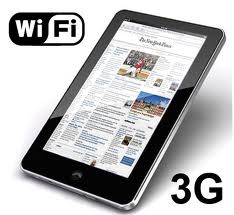The Differences Between Wi-Fi and 3G

What’s the Difference Between 3G and Wi-Fi?
What it’s a 3G Notebook, Kindle Fire, or Nook?
The Internet can be a confusing thing. Not what’s on it, but how you access it. In my travels I continue to encounter folks who don’t understand the basics of Internet connectivity–namely, the differences between Wi-Fi and 3G.
This can cause problems, especially for buyers of devices like the Kindle Fire and Nook Color, which rely heavily on Internet access.
 Indeed, I’ll reckon no small number of these devices get returned because users think they’re broken–when what’s really happening is a lack of Wi-Fi.
Indeed, I’ll reckon no small number of these devices get returned because users think they’re broken–when what’s really happening is a lack of Wi-Fi.
So let’s talk Internet. If you have broadband (i.e. cable or DSL) service in your home, you probably also have a router–a device that makes that broadband connection wireless. In other words, you’ve got Wi-Fi.
That’s great when you’re using your laptop, tablet, iPod Touch, or other device around the house, but what happens when you’re in the car? Or at the beach? No Wi-Fi. And that means no Internet.
That’s where 3G comes in. 3G is kind of like “Wi-Fi everywhere,” meaning it provides Internet access via the same radio towers that provide voice service to your mobile phone. (FYI, 4G is the same thing, just faster.)
Ah, but not all devices are equipped to access 3G service. The Kindle Fire and Nook Color, for example, are Wi-Fi-only tablets. That means they can connect to the Internet only where there’s a Wi-Fi hotspot (which, in addition to your home, can be a coffee shop, library, airport terminal, etc.)
Of course, some laptops, tablets, and gadgets are equipped for 3G as well as Wi-Fi. The catch is that you have to pay extra for the former, usually to a carrier like AT&T or Verizon. Whether or not it’s worth it depends on how much time you out of range of Wi-Fi hotspots. (For example, if you travel a lot.)
That said, I think there’s a smarter option than paying for 3G for a single device: buy a mobile hotspot instead. These pocket-size gizmos connect to 3G (or 4G) networks, then share that connection via Wi-Fi to as many as five nearby devices–not just one. And the monthly rates are about the same as you’d pay for one gadget with built-in 3G.

